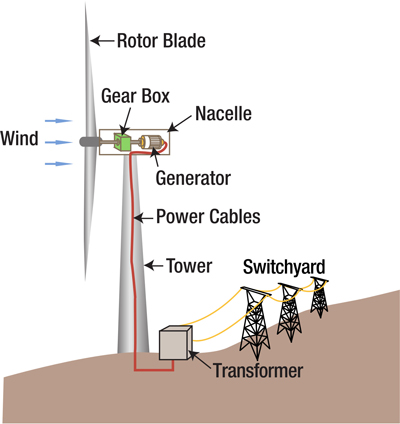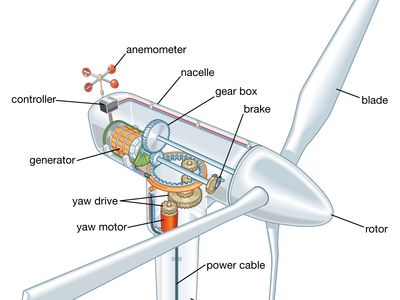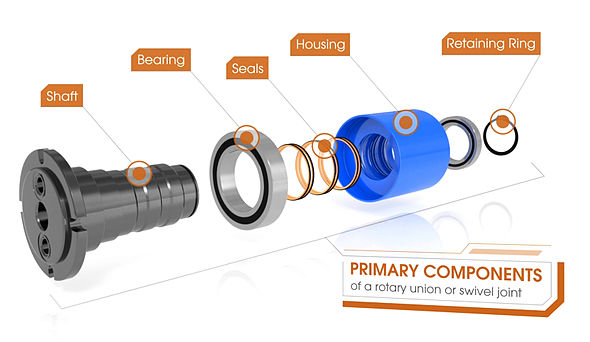What's inside a wind turbine?
A Wind turbine is made up of many different parts all working in perfect harmony to produce the maximum amount of mechanical power which can then be converted into electricity. In alphabetical order here are the individual parts that make up a wind turbine.
Anemometer: This is the part of the wind turbine which measures overall wind speed, records it and then transfers this data to the controller.
Blades: The blades of a Wind turbine are the driving force behind producing mechanical power when the wind blows onto the blades, they either turn or lift, in turn, this causes the rotor within the turbine to spin. Typically most turbines have either two or three blades.
Brake: This is the part of the turbine which can immediately stop the rotor in case of an emergency. This is a legal requirement in most countries.
Controller: The controller is essentially the brain of the turbine, this is the part which starts the entire turbine when the wind hits it between 8-16 MPH, the controller is responsible for shutting off the device if wind speeds exceed 55 MPH. This is to prevent any damage from the high wind and save money on a repair bill, as well as minimizing downtime of the system.
Gear Box: The Gear Box is solely responsible for connecting the low and high-speed shafts, this allows for a huge increase in overall rotational speeds from around 30-60 RPM to somewhere between 1001-1800 RPM. This is the baseline for most generators used today in order for them to be able to output electricity. Typically, the gearbox is heavy and very expensive so engineers across the globe are putting their time and effort into developing generators which are able to run at significantly reduced rotational speeds, which in turn removes the need for a gearbox completely, however this may still be some time away yet.
Generator: The part of the turbine responsible for converting mechanical power into electricity that can be used to power a wide range of applications.
High-Speed Shaft: This part of the Wind Turbine is responsible for being the driving force behind the entire generator, without it the generator itself wouldn’t be able to operate.
Low-Speed Shaft: Main purpose is to rotate between 30-60 RPM.
Nacelle: This part of the turbine is located on the very top of the device and it houses everything listed so far, barring the anemometer and blades.
Pitch: The Pitch is designed to prevent the rotor from being able to turn in wind speeds which are too low to produce electricity (Below 8 MPH) or too high that the turbine may be damaged (55 MPH).
Rotor: The rotor is comprised of the blades and hub together.
Tower: The tower of the turbine is developed to largely assist with supporting the overall weight of the structure, these are especially important in taller turbines, as they stand taller, they are able to convert more kinetic energy due to wind speeds increasing with height.
Yaw Drive: This part of the turbine positions upwind turbines to ensure that they are always facing the wind, even if the direction of said wind changes. There is no limit to how many times the turbine can be repositioned.
The power generated by a wind turbine
The overall power that a specific wind turbine is able to generate is largely dependent on its size, taller turbines can output more electricity than shorter ones due to higher wind speeds running across the blades, on average a Wind turbine with a capacity of 2-3 Megawatts is capable of producing over 6,000,000 kWh of electricity every year.
All electricity produced by a wind turbine is clean and renewable, this means that after installing the device it is not necessary to keep maintaining it, it can be left to operate on its own at very little cost and with no damage to the environment, disregarding minor levels of visual and noise pollution.
Wind Turbines - Types, Sizes, Efficiency
There are a variety of different wind turbines available today ranging from domestic turbines to micro wind turbines, be it for use at home or on a farm, big budget or small, you can be sure there is a wind turbine to best suit your specific needs.
Domestic Wind Turbine
On the market today there are two types of domestic wind turbines available for purchase, these are pole mounted turbines and building-mounted turbines, each has different benefits and fit different situations better than their counterpart. The larger of the pair, pole mounted turbines are able to be built in a relatively exposed location which best enables the turbine to maximize efficiency due to the increase wind speeds available as height increases, this allows for the blades to spin more, in turn, generating higher levels of kinetic energy which then with the use of a generator can be used to make useful electricity. Usually, domestic turbines mounted on buildings operate at a significantly reduced speed as there are numerous factors affecting the turbines, being lower to the ground and having obstructions in the way leads to this type of turbine being less efficient than the other domestic option.
Typically, the price of a 6 kWh pole-mounted turbine is between £22,000 and £32,000, rather costly but with the increased levels of efficiency, they are the go-to option for most people creating their own renewable energy source. Turbines which can be mounted upon buildings weigh in at around £3,000. A significant reduction in price in relation to their counterpart however they are only 1kWh whereas pole-mounted turbines are 6kWh. Some people suggest the purchase of a building mounted turbine isn’t beneficial to you due to the very small amounts of energy produced. However, it depends on your needs and individual situation.
Micro Wind Turbine
A Micro Wind turbine is an energy source which can be taken with you, on the go! Weighing less than 1 kilogram and able to fold down to the size of a relatively thin pole, it is not hard to see why they are put to so much use, however, this doesn’t mean they produce masses of electricity. The energy created is used to power things including USB devices, which shows the relativity of the energy produced in comparison to building and pole mounted turbines. Micro Turbines are again significantly cheaper and can be purchased for around £900 from reputable sources but we suggest giving this a miss if you need any kind of serious level of electrical output.
Wind Turbine for Farm
If you own a farm or have a good amount of land there is now an opportunity for you to generate your own electricity and make a profit too, you can choose to harness the electricity yourself and eliminate your electric bill, or you can opt to sell this electricity back to the national grid and make an income. A range of companies will fit a turbine on your land for no cost and very little personal effort, this is because the energy produced is clean and renewable whereas burning fossil fuels not only damages the environment but is expensive too!
Wind Turbines - Pros and Cons
As with anything in life, there are both pros and cons to wind turbines which I will now discuss here, the list of pros outweighs the list of cons dramatically.
The main pros of having a wind turbine are...
Clean energy source, power created by a wind turbine doesn’t affect the planet negatively.
Renewable source of energy, the wind has no cost
Masses of potential for technological advances leading to more electricity produced in the future
Offer the ability to construct a turbine on existing farms
No air pollution
Minimal operating cost once installed
The negatives aspects of a wind turbine are...
They are a threat to wildlife such as birds and bats
Noise pollution as wind turbines are relatively loud
Visual pollution is another factor as some people believe them to be ugly or an eyesore on the natural landscape
Advantages and disadvantages of wind power
Having the ability to harvest the power of the wind gives us the opportunity to tap into a free, unlimited resource which can be used to generate electricity time and time again. The total savings of using wind turbines are not just limited to those of financial value, more than this something we cannot put a price on. The health of our planet, using wind turbines opposed to getting electricity from sources such as burning masses of fossil fuels in power stations not only best preserve the health of our planet but it ensures that future generations can live their healthiest lives, unaffected by any avoidable pollution.
The notable disadvantages are relatively serious for the time being but this may not always be the case. With further advances in technology, at least one major disadvantage can be removed, this being our current level of technological ability. As this increases more and more electricity can be produced and wind turbines can be made much more efficient, now each turbine has an average efficiency of around 25% but if we continue at the same technological level of advancement within 10 years the efficiency can be raised to 50%, in turn doubling the total output of wind turbines across the globe.
Another disadvantage of wind power is the high cost to set up a turbine, it can easily cost in excess of £30,000 to install a single turbine which can be a massively off-putting to anyone on a limited budget.
How do Wind turbines work
 Wind Turbine Diagram
Wind Turbine DiagramStep by step guide to the inner workings of a Wind turbine
Naturally occurring wind is blown across the blades of the turbine. This wind contains kinetic energy.
When the blades begin to move this causes the rotor to spin around, although the blades seem to be moving quickly from the outside, the central shaft which they are attached to actually turns slowly.
Newly developed turbines have the ability to move the blades depending on the direction of the wind in order to meet the wind at the most efficient angle for harvesting the kinetic energy in the wind. Older turbines usually have rotors that are in one position with the ability to spin around, they do not have the ability to move towards the wind direction so are more often than not largely inefficient when compared to modern turbines
The gearbox then transfers the low-speed rotation (8-16 RPM) into much higher speeds (anywhere up to 1800 RPM) which allows electricity to be generated by the generator, this is not possible at lower speeds so the gearbox is, for now, an essential part of the overall turbine, although is heavy and costly.
Next, the generator which is located directly behind the gearbox now gathers the kinetic energy from the rotating drive shaft and converts this into electrical energy which can be used to power homes, schools and many other things.
Now the anemometer is used by the turbine to measure the wind speed and direction, letting it know if it needs to move to maximize overall mechanical power output.
If the wind speed is in excess of 55 MPH on the readings by the anemometer the brakes will then be applied to prevent any damage to the turbine, if the blades need to be moved to increase efficiency this will happen now.
Now a cable running parallel to the side of the tower carries the current produced by the generator.
Next, a large step-up transformer is now needed to be used to amplify the current into a significantly higher voltage so that it can then be used in homes or buildings. If this is not the case and the electricity is flowing into the national grid it is further amplified to around 125,000 Volts.
Each home receiving this power is getting energy from a clean, renewable source and are safe in the knowledge that the planet wasn’t negatively affected in the production of their electricity.
Wind Turbine Installation
To install a wind turbine takes a high degree of skill, practice, and knowledge. This is not something you can do alone straight out of a flat back box, it requires meticulous planning and extremely high levels of precision to successfully install a wind turbine.
First things first we need to begin in the same way the majority of construction jobs start, digging the foundations. Deep trenches need to be excavated to house the electrical cables that run from the turbine itself to the inverter and control unit of the turbine.
Next, is the building work of the tower itself, as we said before this may require outside help, the use of a crane for this purpose is common practice.
After this step is complete it is now time to enlist the help of an electrician as the DC of the wind turbine needs to be connected to the main control box and then to the inverter. It is common for some safety devices (such as isolators) to be installed at this stage.
Now it is time to get in touch with your local DNO (District Network Operator) to ensure a connection between your wind turbine and the grid. At this stage, the installer should carry out some final checks to make sure firstly that the turbine is safe and secondly that it is working how it should be. Your turbine will be registered on a national database which monitors the total energy output of your latest installation.
Wind Turbine Maintenance
Although wind turbines are self-sufficient and work on their own with no need for human interaction it is essential that they are maintained to a high standard. This ensures that the wind turbine is maximizing output and is being as efficient as possible if not overall electricity output is affected and the amount of electricity produced is reduced significantly. Most wind turbines can be accessed remotely to off-site which reduces the time needed to individually visit and check on each remote turbine as in the past, further saving money too. However, although most do have the new feature some older versions do need to be visited remotely to ensure they are working as they should be.
Slip Ring for Wind Turbine
A slip ring is perfect for use in a wind turbine as a form of rotation is needed whilst conveying force or signals. Slip Rings are able to perform a variety of different tasks although the primary objectives are to streamline all aspects of mechanical performance and aim to remove the need for excessive amounts of wires which dangle from mobile joints, this makes them perfect for use in a wind turbine as there are wires in the nacelle that are stationary that connects to equipment in the hub of the turbine which is rotating. If a slip ring wasn’t used these wires would eventually twist and break leading to a costly maintenance repair bill. The compact size of the slip ring also makes them perfect for use inside the nacelle, if it was too big there would be minimal room for other necessary components. We offer a wide range of slip rings to fit hundreds of purposes, we can make custom slip rings too. Get in touch and let us know what you require!
Wind turbine cost
Wind Turbine Cost per kWh for your home
The cost of a wind turbine per kWh is between $0.007, this figure includes both operating costs and capital. This comes in cheaper than the energy created by clean-coal plants ($0.11) but slightly more costly than natural gas burning plants which cost $0.006 per kWh. With the latest advances in technology we are living in an age where we are seeing the price of wind energy fall drastically whilst the price of coal and nuclear energy continues to rise. This is paving the way for huge investment into wind energy and making turbines more efficient across the globe. As prices continue to rise in the gas sector, we will further see more advances in a shorter space of time as suppliers realize that renewable energy is the future of our planet.
Conclusion
Wind turbines are the future of our planet and huge investment is imminent, the energy sector as we know it will change dramatically over the next 10 years as the cost of gas continues to rise and the cost of erecting turbines and their maintenance falls. The use of Wind turbines is not only better for our pockets, in the long run, but they are also better for the environment too, with no harmful gases being burned we can get our energy in renewable ways which do not impact our planet or wildlife. Although they are costly for domestic purposes, they are hugely beneficial once installed on a large scale, the original cost is much less than the total operating costs of power plants and Wind turbines do not need excessive amounts of maintenance. Once a year is more than sufficient if there are no issues with the turbine and this saves money. Wind turbines also save money on staff wage bills as they do not require a human to work them, they work independently but more importantly, they go a very long way to preserving our natural world and the fact they produce no pollution further cements their position in the future of our lives.
 Pay Online
Pay Online Get A
Quote
Get A
Quote




